Our Lifestyle
 In the early 1950s, most of the major furniture stores were on West Seventh Street.
Guy Beard, Bond Brothers, Brandon, Davidson, Foster, Ned Johnson, Manufacturer's
Furniture Company, Ewell Mashburn, Ozark Furniture, Stanphill-Criner, Steincamp's,
Strawn, and John Tucker were lined up on West Seventh from Main to Victory.
To create demand for television sets they placed them in their showroom windows,
facing the street, and left them on all night. Every evening found many a family
walking up and down Seventh to watch and lust. Some took
chairs and camped out in front of the showroom windows from the time the store closed until the
midnight signoff, even though they couldn't hear the
shows they were seeing. Our family did its share of gawking, and around
1953 my dad gave in and bought a Zenith.
In the early 1950s, most of the major furniture stores were on West Seventh Street.
Guy Beard, Bond Brothers, Brandon, Davidson, Foster, Ned Johnson, Manufacturer's
Furniture Company, Ewell Mashburn, Ozark Furniture, Stanphill-Criner, Steincamp's,
Strawn, and John Tucker were lined up on West Seventh from Main to Victory.
To create demand for television sets they placed them in their showroom windows,
facing the street, and left them on all night. Every evening found many a family
walking up and down Seventh to watch and lust. Some took
chairs and camped out in front of the showroom windows from the time the store closed until the
midnight signoff, even though they couldn't hear the
shows they were seeing. Our family did its share of gawking, and around
1953 my dad gave in and bought a Zenith.
 The Prospect Theater, was at 620 Beech Street a half block south of Kavanaugh
in Hillcrest (it's "Beechwood" now, but it was was "Beech" then, amid a series of
streets named after trees).
The Prospect Theater closed and the facilities became Little Rock’s first television
station, KRTV, in April of 1953.
It was a UHF station and a special antenna had to be purchased to pick it up
(it looked like a big metal bow-tie, that's it on the right),
but for the first time we could watch our favorite shows
without trying to squint through the snow on the broadcast from WMC-TV in Memphis.
A year later KRTV was sold to Pine Bluff’s VHF station KATV, Channel 7, which
debuted in December of 1953.
The Prospect Theater, was at 620 Beech Street a half block south of Kavanaugh
in Hillcrest (it's "Beechwood" now, but it was was "Beech" then, amid a series of
streets named after trees).
The Prospect Theater closed and the facilities became Little Rock’s first television
station, KRTV, in April of 1953.
It was a UHF station and a special antenna had to be purchased to pick it up
(it looked like a big metal bow-tie, that's it on the right),
but for the first time we could watch our favorite shows
without trying to squint through the snow on the broadcast from WMC-TV in Memphis.
A year later KRTV was sold to Pine Bluff’s VHF station KATV, Channel 7, which
debuted in December of 1953.
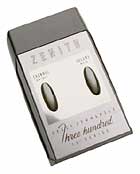 Remote control? Until you reached about the age of 13 YOU were the
remote control, as in, "go put the TV on Channel seven."
You got up and walked across the room to change channels on the TV. And when
you turned the knob
(remember knobs?) it went "clunk", "clunk", ”clunk”, and then the rabbit
ears had to be readjusted. And history has proved that tinfoil on the rabbit ears
was useless.
Remote control? Until you reached about the age of 13 YOU were the
remote control, as in, "go put the TV on Channel seven."
You got up and walked across the room to change channels on the TV. And when
you turned the knob
(remember knobs?) it went "clunk", "clunk", ”clunk”, and then the rabbit
ears had to be readjusted. And history has proved that tinfoil on the rabbit ears
was useless.
The first wireless remote control, Zenith's "Space Commander", showed up in 1957. We never had one. Kid labor was cheaper.
There were four television channels at the most. You could clunk over to channel 2 (PBS), 4 (KARK-TV), 7 (KATV), or 11(KTHV).
TV lamps sat on the television because we were told that watching TV in a darkened room would "ruin your eyes". Ours was a chartreuse panther exactly like the one HERE. Later on, we were told that watching TV in a darkened room wouldn’t “ruin your eyes” after all. The TV lamp manufacturers quickly changed the name to “mood lamps” to try to keep sales going, but it was to no avail. TV lamps died dead.
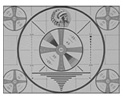 All the TV stations went off the air at midnight, just after “Sea Hunt” starring Lloyd
Bridges, and for a while after sign-off we saw what no modern day teenager has never
seen: a test pattern. The non-politically-correct one with the Indian chief at the
top of the circle, like the one on the right.
All the TV stations went off the air at midnight, just after “Sea Hunt” starring Lloyd
Bridges, and for a while after sign-off we saw what no modern day teenager has never
seen: a test pattern. The non-politically-correct one with the Indian chief at the
top of the circle, like the one on the right.
We preceded transisterized televisions, which Sony introduced in 1960. So when the TV went out we took the back off, removed all the tubes, and headed to Town and Country drugstore to check all the tubes at the tube testing machine and buy at least one new one. We hoped we found a bad one, otherwise we had to haul the set down to Mabelvale Pike to Lt. Col. Kleese (retired), Joyce Kleese's (class of '61) father, and he would fix it for us.
You could buy a sheet of translucent acetate with colored stripes on it. You scotch-taped it to the TV screen and you had instant "color TV". People actually did this.
In the late 1950s somebody got the bright idea to establish the "Little Rock Trail" so that tourists could merely follow the trail around the city to see the sights and eat their meals and do their shopping. Some restaurants, like Hank's Dog House, advertised that they were "on the Little Rock Trail". But the trail, which you can see HERE, was short lived. Most businesses (read that "most influential businesses") were downtown on Main, Broadway, and points between, and newer businesses were expanding out Cantrell, the New Benton Highway, and other areas, following the residential explosion. These businesses were no where near the trail boundaries. The concept was so short lived that most people never knew of its existence.
Weekly allowance was a quarter. As you got older it bumped to fifty cents. Much later it went to a dollar. A dollar was average for mowing yards. Girls were fortunate to get seventy five cents a night for babysitting.
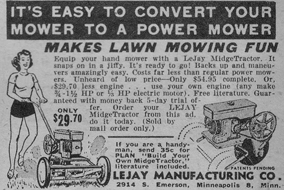 The only mowers were reel-type push mowers. The first gas powered ones were also
reel-type. The problem wasn't rotary blades, the problem was that no one had yet
made a gasoline engine with a vertical shaft to power a rotary blade. These
engines came along later in the 1950s and were made specifically for lawn mowers.
The ad at the right is from 1950. Notice that if you wanted to make something look
easy, you depicted a woman doing it.
The only mowers were reel-type push mowers. The first gas powered ones were also
reel-type. The problem wasn't rotary blades, the problem was that no one had yet
made a gasoline engine with a vertical shaft to power a rotary blade. These
engines came along later in the 1950s and were made specifically for lawn mowers.
The ad at the right is from 1950. Notice that if you wanted to make something look
easy, you depicted a woman doing it.
We never walked past a penny lying on the ground. Five pennies made a nickel and a nickel bought a Barq’s. A nickel also mailed a letter and two postcards. Even after they raised the price to a dime they still called them “penny” post cards. Lord help you if you swallowed a penny, because your mother made you retrieve it and show it to her. There’s only one way to do that.
"Silver pennies" showed up occasionally in a pocketful of change. During World War II, copper was in high demand for the war effort so in 1943 the US treasury stopped using copper in the making of pennies, using steel and zinc instead. The pennies had a silver color and were sometimes referred to as "silver pennies" or "steel pennies". Only collectors have them now.
In 1963, The united States Post Office introduced zip codes and two-character state abbreviations. Three characters would have been better. Our abbreviation for Alaska was "Alask", Alabama was "Ala", Arizona was "Ariz", and Arkansas was "Ark". Then the post office standardized them to two characters and nobody has gotten them right since. Go on Ebay and you'll find that Fairbanks is in AL, Little Rock is in AK, Phoenix is in AR, and there is no state named AZ.
Roosevelt Road was once known as the "Broadway of America".
 University Avenue was once named Hayes Street (In sequence with other presidents)
and it was NOT paved. Hayes Street was paved in the early 1950s, and it was renamed
University Avenue in 1957 to commemorate the ascension of Little Rock Junior College
to university status, to be known thereafter as Little Rock University, or at least
until 1969, when it merged into the University of Arkansas system and became The
University Of Arkansas At Little Rock. At the same time Hayes Street was renamed,
the stretch of highway from Asher Avenue
to Benton, known as the "New Benton Highway", was renamed South University. Most of
us old timers still call it the New Benton Highway, and always will. It doesn't
seem worth the effort to re-educate brain cells at this point.
University Avenue was once named Hayes Street (In sequence with other presidents)
and it was NOT paved. Hayes Street was paved in the early 1950s, and it was renamed
University Avenue in 1957 to commemorate the ascension of Little Rock Junior College
to university status, to be known thereafter as Little Rock University, or at least
until 1969, when it merged into the University of Arkansas system and became The
University Of Arkansas At Little Rock. At the same time Hayes Street was renamed,
the stretch of highway from Asher Avenue
to Benton, known as the "New Benton Highway", was renamed South University. Most of
us old timers still call it the New Benton Highway, and always will. It doesn't
seem worth the effort to re-educate brain cells at this point.
Speaking of streets. Street signs weren't made of reflective steel. They were made of concrete. And unlike in big cities like Dallas the street names weren't molded into the concrete, but, at least in my neighborhood, were stenciled on with the same stencils we used to make posters in school, although a larger type was used. That's my best representation on the right.
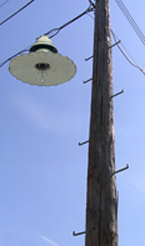 Speaking of street signs, You couldn't read them unless they were under a street light,
and even then it was a daunting task.
We preceeded mercury vapor and all other modern lighting systems. Downtown street lights
were acorn globes mounted on massive cast iron posts. But in the neighborhoods, at least
in ours, street lights were like the one on the right. They consisted of a "radial wave"
style shade and an ordinary 500 watt clear light bulb, which made a great BB gun target.
Ours
were out more than they were on simply because of the huge armory of BB guns that awaited
the streetlight maintenance crews on their weekly rounds.
Speaking of street signs, You couldn't read them unless they were under a street light,
and even then it was a daunting task.
We preceeded mercury vapor and all other modern lighting systems. Downtown street lights
were acorn globes mounted on massive cast iron posts. But in the neighborhoods, at least
in ours, street lights were like the one on the right. They consisted of a "radial wave"
style shade and an ordinary 500 watt clear light bulb, which made a great BB gun target.
Ours
were out more than they were on simply because of the huge armory of BB guns that awaited
the streetlight maintenance crews on their weekly rounds.
When the utility man came out to change the streetlight bulbs, he didn't have a truck with a powered bucket to lift him up. Instead, he strapped spikes to his shoes and grabbed the pole and climbed to the top. All the utility poles had spike marks from the spikes. Poles that had to be climbed often had climbing step-pins imbedded, like the one at the right. The lowest pin was about eight feet from the ground. That was supposed to be too high for the average kid to reach. It wasn't, though. By the way, there were no overweight utility workers in the fifties.
Everyone is complaining of global warming, but during the Christmas holidays of 1955 Little Rock was sweltering from 80-degree temperatures. People went shopping downtown on Christmas eve in short sleeves. It hasn't been that bad since, even in 2005. The heat of December, 1955, was followed by.........
One of the heaviest snowfalls on record came down in January of 1956, closing the schools and most businesses. Hayes street hill, which was paved by 1956, was closed to traffic, right where Forest Heights Middle School (nee Forest Heights Junior High School) is now, and kids - who couldn't make it to school because of the snow - came from miles away to go sledding all day.

 Mom had a washing machine. Mom did not have a clothes dryer.
Clothes were dried outside on a clothesline, and held
on the line with wooden spring-loaded clothespins. In the winter, the clothes
would freeze solid while hanging on the clothesline. Jeans were heavily starched,
so they would hold a crease.
The legs of the jeans were stretched
with steel pants stretchers like the ones on the left
which saved mom the agony of ironing a pair of jeans that were as stiff as a steel plate.
And I promise you that the perfumey smell of a t-shirt dried in a dryer with a dryer sheet
will never come close to the
smell of a t-shirt dried in the sun.
Mom had a washing machine. Mom did not have a clothes dryer.
Clothes were dried outside on a clothesline, and held
on the line with wooden spring-loaded clothespins. In the winter, the clothes
would freeze solid while hanging on the clothesline. Jeans were heavily starched,
so they would hold a crease.
The legs of the jeans were stretched
with steel pants stretchers like the ones on the left
which saved mom the agony of ironing a pair of jeans that were as stiff as a steel plate.
And I promise you that the perfumey smell of a t-shirt dried in a dryer with a dryer sheet
will never come close to the
smell of a t-shirt dried in the sun.
Speaking of clothespins, I once knew how to make a zip gun with two wooden spring-loaded clothespins. It didn’t shoot bullets, it shot wooden matches. Shot at the sidewalk, the matches would make a popping sound then fizzle out. I could probably figure out how to make one today, if I could find wooden spring-loaded clothespins. UPDATE: You will find instructions for making a clothespin matchstick gun by clicking HERE. This one is not exactly like our version, because we used both wooden halves of the clothespin whereas this version only uses one half.
 Cola bottle caps were made of steel and lined with real cork.
If you took a pocket knife and carefully removed the cork, you could put the bottle
cap on the outside of soft cloth, like a T-shirt, and put the cork on the inside and
press it into the cap and the cap was then attached to the cloth. As long as you
didn't stretch the cloth too much the cap would stay there. In the Archie comics,
the Jughead character wears this funky hat with tags and stuff attached. A lot of
people think the round thing is a button, but cartoonist Tom Moore never
put dots for buttonholes in the round thing because it's not a button. It's a
bottle cap attached to the hat just as I have described.
Cola bottle caps were made of steel and lined with real cork.
If you took a pocket knife and carefully removed the cork, you could put the bottle
cap on the outside of soft cloth, like a T-shirt, and put the cork on the inside and
press it into the cap and the cap was then attached to the cloth. As long as you
didn't stretch the cloth too much the cap would stay there. In the Archie comics,
the Jughead character wears this funky hat with tags and stuff attached. A lot of
people think the round thing is a button, but cartoonist Tom Moore never
put dots for buttonholes in the round thing because it's not a button. It's a
bottle cap attached to the hat just as I have described.
A bicycle became a motorcycle by clamping cards to the frame so they plucked the spokes. The cards were held on with wooden spring-loaded clothespins.
If you stomped on a couple of tin cans just right, they would clamp to the soles of your shoes and you could walk around like that making a clop, clop sound. I don’t know why we did that.
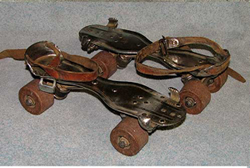
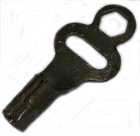 Roller skates clamped to the soles of your shoes. And they had steel wheels.
That's an old rusty pair on the left. Shoe
skates were reserved for the "roller rinks", and had wooden wheels, no good for
sidewalk skating. To adjust clamp skates you needed
a "skate key" like the one on the right. In the 1960s metal wheels gave way to
lightweight polyurethane ones and shoeskates became the standard and clamp skates
disappeared. By 1972, when Melanie sang, "I've got a brand new pair of roller skates,
You've got a brand new key," the symbolism was already lost to the next generation.
Roller skates clamped to the soles of your shoes. And they had steel wheels.
That's an old rusty pair on the left. Shoe
skates were reserved for the "roller rinks", and had wooden wheels, no good for
sidewalk skating. To adjust clamp skates you needed
a "skate key" like the one on the right. In the 1960s metal wheels gave way to
lightweight polyurethane ones and shoeskates became the standard and clamp skates
disappeared. By 1972, when Melanie sang, "I've got a brand new pair of roller skates,
You've got a brand new key," the symbolism was already lost to the next generation.

The strongest drug most of us used on a regular basis was Clearasil. Coke was a soft drink, grass was something you mowed, pot was something you cooked in, smack was something your mother did to you when you sassed her, speed was what you bragged your car would do, acid was what you had to put in your car’s battery to make it work, blow was what your tire did after about 12,000 miles, crystal was what you found on the ground anywhere near Hot Springs, a cap was a little piece of red paper that made a popping noise if you hit it with a hammer or shot it in a cap gun, chalk was what your teacher used to write on the blackboard, a dime was ten cents and a dime bag was unknown because bags were free at the grocery, a kilo was something you heard was used to measure stuff in Europe, reds were communists, a reefer was a big walk-in refrigerator that most restaurants had, a roach was a bug in the kitchen, snow was freezing precipitation, and crack was something in the sidewalk that if you stepped on you’d break your mamma's back.
We didn’t get ritalin. We got slapped.
We didn't get Prozac. We got sent to the principal's office. There we got sent home. There we got slapped.
Viagra? We didn’t need no stinkin’ Viagra.
We predated the expression “trying to find yourself”. We always knew where we were.
"Adult" meant "intended for grown-ups", not "risque".
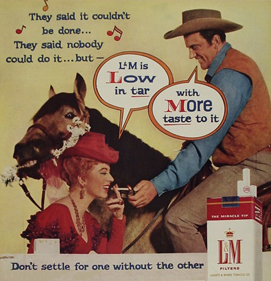 Most guys smoked. Few girls did (in public, anyway) because it wasn’t considered
ladylike (most girls cared about their reputation.)
The tobacco-lung cancer link was known in the late 1940s but disputed.
The ads and commercials were everywhere. L.S.M.F.T. (Lucky Strike Means Fine
Tobacco), “Call for Phillip Morr-eeahse” (Phillip Morris), “Not a cough in a
carload” (Chesterfield), “They said it couldn’t be done, but L&M
did it” (gave you
lower tar and great taste). Kent had the micronite filter (which was made of
asbestos!),
and Marlboro had the tattooed man (Wayne McLaren, the Marlboro man, died of lung
cancer in 1992).
Most guys smoked. Few girls did (in public, anyway) because it wasn’t considered
ladylike (most girls cared about their reputation.)
The tobacco-lung cancer link was known in the late 1940s but disputed.
The ads and commercials were everywhere. L.S.M.F.T. (Lucky Strike Means Fine
Tobacco), “Call for Phillip Morr-eeahse” (Phillip Morris), “Not a cough in a
carload” (Chesterfield), “They said it couldn’t be done, but L&M
did it” (gave you
lower tar and great taste). Kent had the micronite filter (which was made of
asbestos!),
and Marlboro had the tattooed man (Wayne McLaren, the Marlboro man, died of lung
cancer in 1992).
When NASCAR named their championship trophy the Winston Cup that came as no surprise to us, because Winston cigarettes dominated the market. When the “Winston tastes good, like a cigarette should” slogan drew the ire of educators, R. J. Reynolds had a stereotyped thick-glasses matronly woman correct the speaker with, “As a cigarette should.” Then Madison Avenue followed that with, "What do you want, good grammar or good taste?" "As" died and "Like" moved on into the 1960s.
When we began to take the cigarette-lung cancer link seriously in the 1960s a lot of guys switched to pipes and cigars because it was claimed that pipe and cigar smokers got cancer less often and so the rumor started that it wasn’t the tobacco but the cigarette paper that was the culprit. Turns out that pipe and cigar smokers just inhaled less.
If you did smoke cigarettes, there was a time in the 1950s when cigarettes were 23 cents a pack. But vending machines only took quarters, so packs of cigarettes in vending machines were wrapped in cellophane and the package included two pennies to eliminate the need to dispense change.
If you were a kid you couldn't wait to smoke. Until then, you could buy a box of candy cigarettes and pretend.
We went steady and the girls wore a class ring with tape, or maybe angora, wrapped around it because it was five sizes too large.
First you got married, then you lived together. We were told, “It’s not like getting a new car. You don’t get to drive it before you buy it.”
Divorce was rare. We were told, “It’s not like an old car. You don’t get to trade it in on a newer model.”
We played touch football, baseball, and basketball (we never heard of soccer) with no adults around, no parents to scream at the umpires, and no parents ever got into a fight in the stands.
The worse humiliation one could suffer was being picked last for a team. There were 30 in P.E. class. Think about that. If we played softball and you got picked last, that meant 29 people thought you were scum. Later on, at the U of A, I learned that all social animals have a pecking order, like wolves and chickens, and mentally I added, "and P.E."
The term "race" never referred to anything but two cars on a quarter mile of straight two-lane asphalt. There were two preferred quarter mile stretches: out behind the airport and way out Chicot Road.
“Old” and “older” referred to anyone over 20. A girl who dated an “older” guy risked tarnishing her reputation. Most girls cared about their reputation. The magic age was 20 because if you were older than that you could, and probably did, buy alcohol.
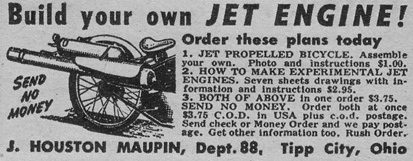
Always wanted to order the plans and build one of these.
How cool would
that
have been to pull into the parking lot at Fair Park Elementary
with one of these monsters mounted on my J. C. Higgins and stroll into sixth grade
class?
Biggest obstacle? The $3.75.
Motorcycles of choice were Cushman Eagles, Triumphs, and Mustangs. Harleys were something the motorcycle gangs rode. Motorcycle gangs were people who lived far, far away. If you were fortunate enough to own a motorcycle, when you got home you just parked it in the driveway or on the street next to the family car, which probably had the key in the ignition. Nobody bothered either of them.
 Taking the driver’s test to get a learner’s permit in 1956: (1) To turn right,
stick your left arm out of the left window and bend your elbow 90 degrees and point
to the sky, (2) To turn left, stick your left arm straight out of the left window and
point straight to the left, and (3) to slow down or stop, stick your left arm out of
the left window, drop it down at a 45 degree angle, and show your palm to the driver
behind. Notice that nowhere in those instructions does it say anything about
extending your middle finger.
Taking the driver’s test to get a learner’s permit in 1956: (1) To turn right,
stick your left arm out of the left window and bend your elbow 90 degrees and point
to the sky, (2) To turn left, stick your left arm straight out of the left window and
point straight to the left, and (3) to slow down or stop, stick your left arm out of
the left window, drop it down at a 45 degree angle, and show your palm to the driver
behind. Notice that nowhere in those instructions does it say anything about
extending your middle finger.
Junior Deputies for guys. Did the girls have something similar?
 If you got a cold, your mom probably rubbed something on your chest. There were two
kinds of moms in this respect. There were Vick's Salve (actually, Vick's VapoRub)
moms and there were Ben Gay moms. Both stunk. Neither helped.
If you got a cold, your mom probably rubbed something on your chest. There were two
kinds of moms in this respect. There were Vick's Salve (actually, Vick's VapoRub)
moms and there were Ben Gay moms. Both stunk. Neither helped.
If you got a scrape your mom probably swabbed something on the wound. There were two kinds of moms in this respect. There were Iodine moms and there were Mercurochrome moms. Mercurochrome was great. Iodine (actually tincture of iodine) burned like fire. Thank heavens my mom was a Mercurochrome mom. I was always careful at my aunt's house in Benton, because she was an iodine mom. Buying tincture of iodine these days can get you looked at. It's an ingredient used in the manufacture of methamphetamine.
Your mom probably made you use mouthwash. There were two kinds of moms in this respect. There were Listerine moms and there were Lavoris moms. My mom was a Lavoris mom. Listerine might have single-handedly caused millions of potential long-term relationships to end on the first date. By the way, in the fifties Listerine advertised that regular use may help cure the common cold. Then the FDA stepped in and said, "No it doesn't, so you can't claim that any more." So the Listerine advertisers looked around and came up with a disease that it does cure: gingivitis. The FDA couldn't argue with that, because Listerine does cure gingivitis. So does Jack Daniel's Tennessee Whiskey and Aunt Clara's dill pickle juice. No one had ever heard of gingivitis before Madison Avenue came up with it, but today even toothpaste makers make the claim and millions of paranoid brushers and garglers buy the cure. It must work because nobody has gingivitis, just like in the fifties.
You could tell a lot about somebody by noting what kind of toothpicks they used. There were two kinds of people in this respect. There were flat toothpick people and there were round toothpick people. We were a flat toothpick family. That's not to say we were prejudiced against round toothpick people, and in fact some of our best friends were round toothpick people. But really, the only valid use for a round toothpick is spearing hors douvres, and we didn't eat hors douvres (which we called horse ovaries). We ate tidbits, nibbles, or munchies, so round toothpick people were considered hoity-toity.
Sunday funnies:
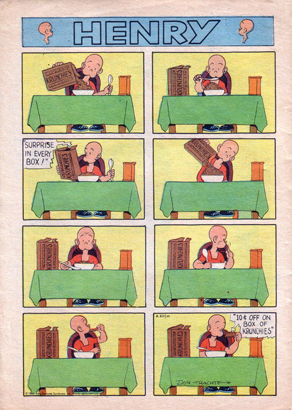
Dick Tracy (2-way wrist radio. Later on, 2-way wrist TV. "Never happen," we said.)
Mutt and Jeff (The original odd couple.)
The Katzenjammer Kids (Usually got their butts beat by the Captain or Mamma.)
Prince Valiant (Booooring. I read it to delay shining my shoes for church.)
Little Orphan Annie ("Arf, arf.")
Bringing Up Father (We learned about gout, corned beef and cabbage, and nagging.)
Little Lulu (actually had a fat boyfriend, Tubby.)
Henry, the hapless little bald guy.
Nancy and Sluggo (What the hell was that cactus plant hairdo all about?)
Mandrake the Magician ("Mandrake gestures hypnotically.")
Smokey Stover ("Notary Sojac", "Foo", "1506 Nix Nix".)
Blondie and Dagwood (Did you know Blondie's maiden name was Boopadoop? It's true.)
Barney Google ("Awww, Sparky, I'd never turn you into glue.")
Li'l Abner (I could use a Shmoo right about now.)
Joe Palooka (Humphrey Pennyworth and his tricycle outhouse.)
Pogo ("Deck us all with Boston Charlie, Walla Walla, Wash, an' Kalamazoo.")
Archie (and Betty, and Veronica, and Jughead.)
Sad Sack (I knew several.)
Our Boarding House (Major Hoople, "Nov shmoz ka pop?")
Whippoorwills. When was the last time you heard a whippoorwill? They're still out there, but when was the last time you slept with the window open in the summertime so you could hear one?
Catching lightening bugs. You put one on your finger and you had a diamond ring. You packed them into a jar and went inside to the closet, way in the back behind the winter clothes, where they lit up your world. When was the last time you saw a lightening bug? For that matter, when was the last time you saved a jar?
 I used to make an airplane out of a Japanese beetle. Tried it with June bugs but
they just don't work. It has to be a Japanese beetle, the big one with the shiny
iridescent wings. Just get a six-foot long piece of thread and tie one end to one of
its hind legs and hold on to the other end of the thread and throw the beetle into
the air. Most of the time it will start flying and it will fly around and around
until it gets tired. Let it rest a while, then throw it up again. It will last from
after supper until dark.
I used to make an airplane out of a Japanese beetle. Tried it with June bugs but
they just don't work. It has to be a Japanese beetle, the big one with the shiny
iridescent wings. Just get a six-foot long piece of thread and tie one end to one of
its hind legs and hold on to the other end of the thread and throw the beetle into
the air. Most of the time it will start flying and it will fly around and around
until it gets tired. Let it rest a while, then throw it up again. It will last from
after supper until dark.
Immediately after World War II, we lived on Wolfe Street across from Centennial School. Butter was rationed in the War and still wasn't readily available, so we used margarine. However, to keep unscrupulous people from selling margarine in the guise of butter, by law it couldn't be colored yellow. So each package of margarine included a little packet of orange powder and you mixed it into the margarine yourself. I remember watching my grandmother mix and mix and mix and mix.
Later on, we moved to 1401 South Fillmore and we moved up a notch in the world when we acquired an ice box. I remember the ice man delivering ice several times a week. He had a big pair of ice tongs and he had a leather pad on his back. He used the tongs to grab a big block of ice and he threw it onto his back and brought it into the house and put it into the top of the ice box, right where the freezer compartment is now. Some of us old timers still call a refrigerator an "ice box". We also might call it a Frigidaire, because that was the biggest seller in the fifties and most of us owned one.
You probably did not have central heat or central air conditioning. In fact, you probably didn't have air conditioning at all. If you did, you probably had window units. If you didn't, you most likely had a ceiling fan and a floor furnace. Nothing beats sleeping in the window with the ceiling fan going. The night noises put you right to sleep. That is, unless the night noises come from the neighbor's beagles across the street. And when you wake in the dead of winter, nothing beats standing on a floor furnace to get your body ready for breakfast and a bath and school. Central heat and air conditioning is modern, convenient, efficient, cost effective, and boring.
Stuff we did that had politically incorrect names:
Indian Burn was perfect for little brothers, the obnoxious kid next door, and
any witless neophyte. You gave any of them an Indian burn by grasping their wrist
tightly with both of your hands positioned next to each other, and then twisting
your two hands in opposite directions. You kept this up as long as they let you, even
after they started screaming and trying to pull away.
It was painful, and turned the skin red (thus the name.)
Mexican braid is along the lines of the Indian burn. You grabbed the bottom of
the victim's forearm with one hand and placed the open flat
palm of your other hand on top of the forearm where there's lots of hair and you moved
your
palm rapidly in a circular motion, all the while pressing down. This caused the
hair of their arm to become knotted together in tight little "pills". It was painful
because the pills pulled the hair and if you touched one it pulled more, and the pills
would not come undone. You had to shave them off to get any relief. Like the Indian
burn you tried to keep it up even after they started to scream and get away because the
longer you did it the more pills you made and the tighter they became. The Mexican
braid was especially fun to do to girls because the fine hair on their arm made a
really tight knot and it drove them crazy.
Chinese fire drill is technically any situation in which lots of people are
running around frantically and accomplishing absolutely nothing, but in our version
when a car stopped at a red traffic light someone yelled "Chinese fire drill", and
everyone got
out and ran around the car and got back into a different door than the one they
exited - all before the traffic light turned green.
Chinese finger torture was a toy that you got at a carnival, the livestock
show, at Woolworth's, or even as a prize in Cracker Jacks. It was a woven tube
about six inches long. If you stuck your finger in one end and tried to pull it
back out, the thing tightened on your finger, and the harder you pulled the
tighter it squeezed. It was a particularly joyous occasion to find somebody who
had never seen one, because you got them to put an index finger in each end and it was
as good as handcuffs. They were easy to get out of, but only if you knew the
secret. That's a Chinese finger torture toy below.

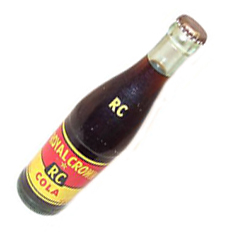
Drink machines dispensed glass bottles. The best drink machines weren't the
upright kind, they were chest-type and they suspended the bottles into a bath
of ice cold water.
The hands down favorite was an RC
Cola, because you couldn't distinguish it from Coke and although at ten ounces it was only
two ounces more than a coke, well, two ounces was two ounces. A favorite method of
consumption was to drink a little of the cola to make some room and then
pour a package of Tom's Peanuts into the bottle.
Glass soft drink bottles were redeemable for 2 cents each, from the 10-fluid-ounce Barq's to the little 8-fluid-ounce Coca-Cola bottles and even smaller 6-fluid-ounce Grapettes and Tru-ades. There were no bottles trashing out our roads and highways, because if you collected enough bottles you could earn the price of admission to Lake Nixon or Willow Springs.
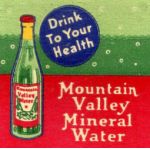 Some company in Hot Springs named Mountain Valley had the audacity to bottle water
and sell it in soft drink machines. What a stupid idea. We all knew nobody would
ever buy a bottle of water.
Some company in Hot Springs named Mountain Valley had the audacity to bottle water
and sell it in soft drink machines. What a stupid idea. We all knew nobody would
ever buy a bottle of water.
Besides, we drank our water from a garden hose, not from a bottle.
It was called "Mineral Water" in the 1950s because all the springs in Hot Springs were called "mineral springs".
When Brother Dave Gardner came to town for an appearance at Robinson Auditorium, he joked about how those dumb, backward hillbillies in Hot Springs were selling bottled water to all those brilliant yankees.
Prior to 1954 all toasters were pop-up toasters. First you made the toast and then you buttered it. If you wanted it the other way around, or if you wanted cheese toast or cinnamon toast, you fired up the oven, which was expensive and time-consuming. Mr. George Munsey of Little Rock decided he wanted his toast buttered first and he wanted it fast. So he invented the "toaster oven" and in 1954 he founded Munsey Products to manufacture the Munsey Toaster. All counter-top toaster ovens are descendants of the Munsey toaster. If you lived in central Arkansas you had one in your kitchen. It didn't have an on-off switch, though there was one on the cord plug if you had the right kind of cord. We didn't. They cost extra. Many of us old-timers use "Munsey" to mean any kind of toaster oven, just as we use "Coke" to mean any kind of soft drink. Munsey Products is still around. They make waffle machines and mixes.
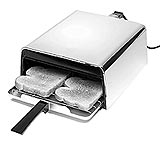 How to make toast using a Munsey toaster without an on-off switch:
How to make toast using a Munsey toaster without an on-off switch:
Ingredients:
4 Slices Wonder, Colonial, or Meyer's bread
Cold butter straight from the ice box
Directions:
1. Remove bread slices from package. Place package on top of Munsey.
2. Using large knife, equally space 4 pats of butter on each slice of bread.
Try to spread butter. Ignore tears in bread.
3. Place bread slices in Munsey tray. Slide tray into Munsey.
4. Straighten prongs on the electrical plug from the last time the Munsey
was used. Maneuver Munsey cord plug into wall socket.
5. When bread package on top of oven starts to smoke and smell bad, quickly
remove it. Place the package big-hole-side down
on the counter so mom won't notice it until
she picks it up and all the bread slices fall to the floor.
6. When smoke comes out of the Munsey, unplug the cord by jerking on it, bending the
prongs on the plug to prepare them for the next use, and quickly remove
tray from the Munsey. Curse, but not too loudly in case mom is out of the bathroom.
7. Holding toast over kitchen sink, use knife (see # 2, above) to scrape toast to
desired shade of gray.
8. Eat toast. The proper technique for eating Munsey toast is to equally mix
soggy parts and dry parts with each bite.
9. Leave for school. Try to get out the door before mom starts screaming about
the bread logo burned into the top of the new Munsey and the blackened mess
in the kitchen sink and the crumbs on the floor and the dirty plate on the
table. She'll be over it by 3:30.
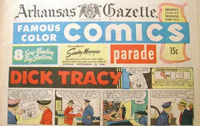 There were once two newspapers. The Arkansas Gazette
("the oldest newspaper west of the Mississippi") was delivered in the pre-dawn hours
of the morning and the Arkansas Democrat was delivered in the afternoon.
For many years the Gazette was the leading newspaper, but in 1974 the Democrat was
sold to a group of investors and new publisher Walter E. Hussman, Jr.,
went after the Gazette, hiring John Robert Starr as managing editor in 1978.
Starr moved the Democrat to morning delivery, offered free want ads, and doubled
his newsroom staff. Feeling the pressure, the Hugh B. Patterson Jr. family sold
the Gazette to Gannett in 1986
and the resulting move toward a USA Today clone did nothing to slow the onslaught.
Starr was aggressive,
the new Gazette management passive, and the result was that the
Democrat absorbed the Gazette and the two become the Arkansas Democrat-Gazette
in October of 1991.
There were once two newspapers. The Arkansas Gazette
("the oldest newspaper west of the Mississippi") was delivered in the pre-dawn hours
of the morning and the Arkansas Democrat was delivered in the afternoon.
For many years the Gazette was the leading newspaper, but in 1974 the Democrat was
sold to a group of investors and new publisher Walter E. Hussman, Jr.,
went after the Gazette, hiring John Robert Starr as managing editor in 1978.
Starr moved the Democrat to morning delivery, offered free want ads, and doubled
his newsroom staff. Feeling the pressure, the Hugh B. Patterson Jr. family sold
the Gazette to Gannett in 1986
and the resulting move toward a USA Today clone did nothing to slow the onslaught.
Starr was aggressive,
the new Gazette management passive, and the result was that the
Democrat absorbed the Gazette and the two become the Arkansas Democrat-Gazette
in October of 1991.
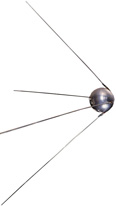 History changed drastically on October 4, 1957, when the USSR launched
the world's first artificial satellite, Sputnik I.
It was about the size of a
basketball, weighed only 183 pounds, and took about 98 minutes to orbit the Earth
on its elliptical path. Sputnik I ushered in a new
era, and marked the start of the space age and the
American-Soviet space race. On my paper route there was an amateur radio enthusiast
who had antennas strung from his house to a park across the street
and in all the trees up and down the block.
A few mornings after the launch, when he heard my paper hit his front porch about 4:00
A.M., he came out and invited me in to his radio shack. I put the ear phones on and
I heard Sputnik going by overhead. It was nothing more than a faint
"beep...beep...beep", but I sensed that it was really big, and that my life would be
profoundly affected by it. You can hear Sputnik 1 as I heard it if you click
HERE.
History changed drastically on October 4, 1957, when the USSR launched
the world's first artificial satellite, Sputnik I.
It was about the size of a
basketball, weighed only 183 pounds, and took about 98 minutes to orbit the Earth
on its elliptical path. Sputnik I ushered in a new
era, and marked the start of the space age and the
American-Soviet space race. On my paper route there was an amateur radio enthusiast
who had antennas strung from his house to a park across the street
and in all the trees up and down the block.
A few mornings after the launch, when he heard my paper hit his front porch about 4:00
A.M., he came out and invited me in to his radio shack. I put the ear phones on and
I heard Sputnik going by overhead. It was nothing more than a faint
"beep...beep...beep", but I sensed that it was really big, and that my life would be
profoundly affected by it. You can hear Sputnik 1 as I heard it if you click
HERE.
This was a persistent urban legend in the fifties. There was this girl who didn't like some boys and they didn't like her. It just so happened that she chewed Chicklets Gum. It also just so happened that Feen-A-Mint laxative gum was about the same size, shape, taste, and color as Chicklets. So the boys distracted her, got the Chicklets box out of her purse, and substituted a couple of Feen-A-Mints for a couple of the chicklets. Many times we plotted to do this to a certain Chicklet-chewing teacher, but never did. Reason? Chicklets cost a nickel, but Feen-A-Mint cost a buck, and we had a lot better things to do with a buck.
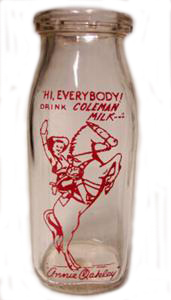 Milk was delivered to your front steps in glass bottles. Some dads collected
the heavy cardboard
bottle caps to use as poker chips for the weekly poker game with the guys.
Later, Coleman Dairy began
to use the new waxed cardboard cartons with a picture of Annie Oakley, played by
Little Rock’s own Gail Davis. Ms. Davis died in 1997.
Milk was delivered to your front steps in glass bottles. Some dads collected
the heavy cardboard
bottle caps to use as poker chips for the weekly poker game with the guys.
Later, Coleman Dairy began
to use the new waxed cardboard cartons with a picture of Annie Oakley, played by
Little Rock’s own Gail Davis. Ms. Davis died in 1997.
Our milk delivery man was Bill Bright's (class of '60) uncle, Buck Bright, who delivered for Coleman Dairy. I would run into Buck most mornings around 4:30 A.M. while on my Arkansas Gazette paper route. Buck would turn a one-quart cardboard carton of chocolate milk upside down and cut the corner off so he could turn it in as damaged. I would drink it down while we talked, then I'd give him my "extra" paper and we'd both be off.
In the summer, the ice cream man came riding down the street on his white tricycle with the icebox on the front, bells a-jingling. We could hear those bells from two miles away and we would sit on the front porch and track his movements through the other neighborhoods until he turned down our street. Dreamsicle bar, my favorite, was a nickel.
Also in the summer the vegetable man drove his pickup truck slowly down the street yelling as loudly as possible, “Strawberries. Cantaloupes. Watermelons.” With no air conditioners to drown him out, and with every window open to capture what breeze there was, the vegetable man attracted a crowd. He must have made a fair living, because he was back year after year.
In the freezer at the neighborhood store were little cups of ice cream called
Dixie Cups.
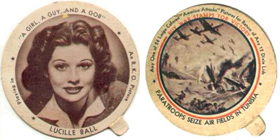
 On the underside of the lid was a picture of a movie star, singer or other
celebrity. During World War II, from about 1942 to 1946,
celebrity pictures were replaced with battle
scenes and patriotic messages.
The name "Dixie" referred to the brand of cup, which is still going strong,
but in each community a local dairy franchised the celebrity cups and marketed them
filled with their own ice cream. Since we preceded plastics,
somewhere
in the freezer was a box of little flat wooden spoons,
like the one on the right, to eat the ice cream with.
You didn’t have to ask. You just knew to look for them.
On the underside of the lid was a picture of a movie star, singer or other
celebrity. During World War II, from about 1942 to 1946,
celebrity pictures were replaced with battle
scenes and patriotic messages.
The name "Dixie" referred to the brand of cup, which is still going strong,
but in each community a local dairy franchised the celebrity cups and marketed them
filled with their own ice cream. Since we preceded plastics,
somewhere
in the freezer was a box of little flat wooden spoons,
like the one on the right, to eat the ice cream with.
You didn’t have to ask. You just knew to look for them.
Paper Guns. Paper toy shaped like a gun that when you whipped through the air, would make a
loud popping sound.
My personal favorite Burma Shave Sign:
| Ben met Anna |
|---|
| Made a hit |
| Neglected beard |
| Ben-Anna split |
| Burma Shave |
Duncan yoyos. They were made of real wood. They're all plastic now. The Duncan yoyo man came around occasionally and he would carve a design of your choice into the face of your yoyo. My favorite was always the "slow boat to China".
St. Vincent’s Infirmary was at Tenth and High prior to their move to Markham and University. Baptist Hospital had the entire two blocks bounded by 11th, 13th, Wolfe, and Marshall. The Missouri Pacific Hospital, shown below, was at 1310 Lincoln. Lincoln Street is gone now, but the hospital stood about where the Dillards headquarters are now located, on the hill overlooking the Arkansas River. I went to the MoPac when I broke my arm in the sixth grade. Went there again a month later when I broke it again using the cast as a softball bat.
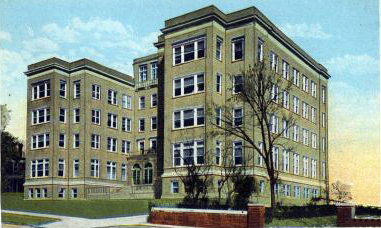
In the city, telephone numbers had phonetic prefixes. Largest were MOhawk, FRanklin, WIndsor, PLaza, and LOcust. North Little Rock was DOgtown. No, wait, maybe it was SKyline.
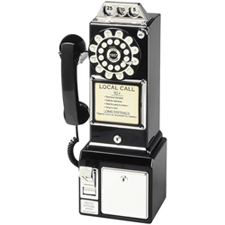 Pay phones were a nickle, then went to a dime.
Unless you knew what to do, then pay phones were a penny.
You stuck the penny in the nickel slot,
but you held it there and didn't let it slip down. Now with the tip of your finger you
FLICKED the penny as hard as you could down into the slot. The penny
went into the nickel bin, and on the way down it engaged the mechanism, and you
had a dial tone. If you didn't do it hard enough, the penny came out the coin
return, and you tried again. Sometimes took several tries.
When pay phones went to a single coin slot instead of the three slots like the one
on the right, the trick no longer worked.
Pay phones were a nickle, then went to a dime.
Unless you knew what to do, then pay phones were a penny.
You stuck the penny in the nickel slot,
but you held it there and didn't let it slip down. Now with the tip of your finger you
FLICKED the penny as hard as you could down into the slot. The penny
went into the nickel bin, and on the way down it engaged the mechanism, and you
had a dial tone. If you didn't do it hard enough, the penny came out the coin
return, and you tried again. Sometimes took several tries.
When pay phones went to a single coin slot instead of the three slots like the one
on the right, the trick no longer worked.
Making a call in rural areas could be complicated. For example, Richard Sparrow (class of '60) lived on Bowman Road in the Rosedale telephone district and in 1954 his telephone number was Rosedale-154-J-4. To call Richard from town you had to dial 116 to reach the Rosedale operator, then she answered (yes, it was always a she) and she asked, "Number, please" and you gave her the last digit, four, and she connected you.
Party lines. Each phone on a party line had a special ring. Maybe two longs and a short for one, a long and two shorts for another. If the call was for somebody else you could time it just right and pick up the phone and listen to the entire conversation. Conversely, you were smart to assume that somebody else was always listening to your conversations. What was that special number you had to dial to reach another person on your party line? Well, depended upon the phone company, but mostly it was a procedure. (1) Dial the listed number. (2) You'll get a busy signal, so hang up. (3) Phone will start ringing. (4) When ringing stops, the other person has answered, so pick up the phone.
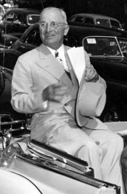 President Harry S. Truman visited Little Rock in June of 1949. We lined 13th street for the
parade. He came by in a big convertible limousine. We had sat on the granite wall
that bordered the Lee School grounds for hours. It was over in less than two minutes.
But hey, we saw the president.
President Harry S. Truman visited Little Rock in June of 1949. We lined 13th street for the
parade. He came by in a big convertible limousine. We had sat on the granite wall
that bordered the Lee School grounds for hours. It was over in less than two minutes.
But hey, we saw the president.
Long before there was an Albertson's or any other commercial enterprise, we rode our bikes out Markham Street past Rodney Parham Road. Just before where John Barrow Road is now (John Barrow was straight in the 1950s, and crossed Markham east of Grassy Flat creek), there was a dirt road that went off to the south for a short distance. Where Grassy Flat Creek merged with Rock Creek there was a real old-fashioned swimming hole just like Norman Rockwell might have painted, with rope swings hanging from the trees and an embankment to dive off of. The creeks are still there, but today "creek" is a misnomer because, sadly, they are no more than drainage ditches.
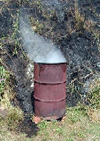
 Every back yard had an incinerator. You took the trash, leaves, and old
newspapers to the incinerator and burned them. If your dad or uncle was a craftsman
your incinerator was probably made of mortar and stone or brick. If not, then
you probably had a 55-gallon barrel like the one on the right.
But you had one or the other.
We preceded plastic bags, so when you raked
the leaves you carried them
to the incinerator in a wooden bushel basket like the one on the left.
Every back yard had an incinerator. You took the trash, leaves, and old
newspapers to the incinerator and burned them. If your dad or uncle was a craftsman
your incinerator was probably made of mortar and stone or brick. If not, then
you probably had a 55-gallon barrel like the one on the right.
But you had one or the other.
We preceded plastic bags, so when you raked
the leaves you carried them
to the incinerator in a wooden bushel basket like the one on the left.
We had homeless people, but they weren’t called homeless people. They were called vagrants or tramps or bums and they could be arrested for “having no visible means of support”. They didn’t stand on the street corner with a sign, either. They came to the back door and offered to trade work for a meal. Given the opportunity, they mowed the yard or raked the leaves, ate their meal, and headed back to the railroad tracks. I always got the impression from talking to them that they weren’t down and out, they just had a kind of fatal wanderlust that they couldn’t shake. I talked to one once as he raked the autumn leaves, and he told me he had spent the summer in Alaska and was on his way to Key West for the winter. Those were strange and wondrous places to me. Now I have been to both and they are no longer strange, but they are still wondrous.
Beatniks. Coffee houses. The first coffee house in Little Rock was at 7th & Victory. I don’t remember the name, but the outside was painted purple. We had an unofficial beatnik day at Mabelvale and everybody went to school dressed like beatniks. Mr. Taylor turned purple. Check out the beatniks HERE.
 At 6:08 A.M. March 31, 1960, we were rocked out of our beds on Forbing Road when
a B-47 Stratojet from the
384th Bomb Wing (Strategic Air Command),
545th Bombardment Squadron at the Little Rock Air Force Base
exploded over Little Rock 13 minutes after taking off.
The main wreckage fell in the area of the intersection
of Maryland and Summit,
creating a crater 35 feet wide and 6 feet deep.
One engine fell not too far from Pulaski Heights
Middle School (nee Pulaski Heights Junior High) and a pilot ejector seat and a
burning, partially opened parachute were found on the school's playground.
One man was killed when a fire destroyed a home on Maryland Avenue, and three
crewmen also died. Incredibly, the plane's co-pilot, Lieutenant Thomas Smoak, 26,
parachuted to safety and was found in a tree behind a house on Midland Street.
Though badly burned, he survived and made a pilgrimage back to the crash site
some twenty-five years later.
At 6:08 A.M. March 31, 1960, we were rocked out of our beds on Forbing Road when
a B-47 Stratojet from the
384th Bomb Wing (Strategic Air Command),
545th Bombardment Squadron at the Little Rock Air Force Base
exploded over Little Rock 13 minutes after taking off.
The main wreckage fell in the area of the intersection
of Maryland and Summit,
creating a crater 35 feet wide and 6 feet deep.
One engine fell not too far from Pulaski Heights
Middle School (nee Pulaski Heights Junior High) and a pilot ejector seat and a
burning, partially opened parachute were found on the school's playground.
One man was killed when a fire destroyed a home on Maryland Avenue, and three
crewmen also died. Incredibly, the plane's co-pilot, Lieutenant Thomas Smoak, 26,
parachuted to safety and was found in a tree behind a house on Midland Street.
Though badly burned, he survived and made a pilgrimage back to the crash site
some twenty-five years later.
Before your Dad and Mom could vote they had to pay a one dollar "poll tax". Later declared unconstitutional, then prohibited forever by the twenty-fourth amendment ratified in 1964, the tax was designed to keep black people, most of whom couldn't pay the dollar, from voting.
When we drove to California in 1954, we had to do something with my pet dog, a mutt named Peewee. Not a problem. My father, not an animal lover, secretly took him to the pound, and I was told that he ran off. I know what his fate was there because I've seen it. The pound was located south of east Roosevelt next to the city dump. There is an area on the maps called "South Little Rock Park", between Main and I-30 and south of Roosevelt. That whole area bounded by 26th, 29th, Main and Cumberland was the dump and on the Google satellite you can see that a public housing project has been built on top of it. The pound had an old V8 engine mounted on a wood frame and the exhaust ran into a metal box. The workers would fill the box with animals, then start the engine. Within about 15 minutes, all the animals were dead, so they picked up the carcasses by the hind legs, walked out behind the pound, and threw them onto the dump. RIP, Peewee.
You can read all about our 1954 trip to California HERE.
"The Castle" on Stagecoach Road. Always mysterious. Always majestic. Always wanted to own it. Still would. UPDATE: Read all about it HERE, and HERE.
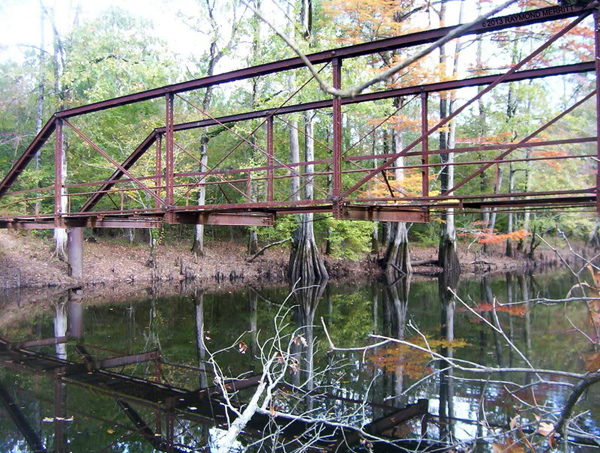
Sibley Hole Bridge was an old Pratt truss bridge on Sibley Hole Road that spanned Fourche Creek and connected Baseline Road to Stagecoach Road. It would have been long lost to history if it were not for the name. I have never found anyone who knew its origin. You can buy a street sign on Amazon.com that states "Sibley's Hole", but the seller doesn't know the origin of the name. Google will tell you that the name "Sibley Hole" exists in one other place on the planet and that it is a mostly dry lake bed west of Las Cruces, New Mexico. With a name like that, the two places must be connected. The Sibley Hole bridge in Little Rock is long gone. I remember driving over it in the late 1950s and wondering, "Lordy, will this 1954 Chevy Make it to the other side?" In its final days, traffic was blocked but you could still walk out on it and drop a line into "Foosh Crick" if you were so inclined. You were guaranteed to not catch anything but carp.
Step on a crack, break your momma's back! Remember Jack Nicholson in the movie "As Good As It Gets"? He believed it. So do I.
Bread and butter. If you're walking down the street with your girlfriend or boyfriend and you get momentarily separated, like if you each have to go around the opposite sides of a telephone pole, then when you get back together again you have to say, "Bread and butter," and it's like you were never separated.
In the back of every magazine was an ad by Charles Atlas like the one HERE. Mister Atlas promised to make a "new man" out of every skinny 97-pound weakling. Well, time did what Charles Atlas couldn't. Now a lot of us who have new bodies would like to have the old one back.
On the subject of weaklings, something you could do in the fifties that you can't do today: remove the plastic wrap from anything without a tool.
In the back of some magazines was an ad like the one HERE that turned lots of kids like me into nine-year-old coupon clipper wannabes. I wanted them all. I could think of a zillion ways to use a voice-throwing device, and there was one girl in particular that caused me to dream about owning a pair of the X-Ray Specs.
Permastone was an entirely new building material that came along in the 1950s and was supposed to revolutionize the home building business because the cost of labor and materials was going out of sight. Both a material and a technique, it was accomplished by putting up solid cement walls covered by thin homemade bricks which were much thinner than traditional bricks and could be colored or tinted in a variety of colors. Although they (sort of) looked like bricks, they were thin slabs that were cemented to the walls. Permastone was met with a warm reception and didn't last much into the 1960s. The Arkansas showcase for Permastone was at Kavanaugh and Spruce streets. The building, one of the last remaining examples of this building style, is still in use (as an animal rescue center), but it is not in good condition and has been scheduled for demolition. The few remaining Permastone buildings cannot be repaired because the process is now a lost art. You can see a picture of a part of the building, showing the Permastone "bricks", HERE.
Even more majestic. Marylake, the Carmelite Monastery at East End, out Arch Street Pike. Read all about it HERE.
Guys all had to register for the draft at age 18. We had a six-year commitment with four years active duty (regulars) or two years active duty plus four years meetings (reserves). We could join the branch of service of our choice, or we could be inducted into the U. S. Army. We could get a college deferment, but many of those who did ended up in Viet Nam, which began in earnest with the Gulf Of Tonkin incident in 1964. When we finally did make it back home, nothing was the same, and would never be the same again.

